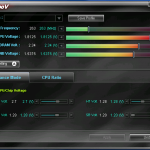Two decades of innovation have kept ASUS at the forefront of motherboard technology
 Since developing its first 486 design in 1989, ASUS has grown to become the biggest motherboard manufacturer in the world and a pioneer in cutting-edge motherboard technology.
Since developing its first 486 design in 1989, ASUS has grown to become the biggest motherboard manufacturer in the world and a pioneer in cutting-edge motherboard technology.
The last 20 years have seen the development of many ASUS innovations, from the introduction of stringent testing for electromagnetic interference that surpassed industry standards of the time, to the first 16-phase power design that improved motherboard power efficiency and provided a more stable platform for overclocking. Not content with past achievements, though, ASUS is constantly striving to create motherboards that will help their users to reach greater heights, whether at work or at play.
Keep up to date with the latest ASUS Xtreme Design Products — designed especially for your needs — by following ASUS on Twitter via www.twitter.com/asusxtreme.
Design Matters
The key to a successful motherboard is good design, and ASUS has a world-class research and development team that’s responsible for the development of groundbreaking new technology.
Let’s take a look at some fundamental design innovations to see what sets ASUS motherboards apart from the competition.
TurboV Realtime Overclocking
Overclocking has become more than just a hobby, and most motherboards now offer the option to squeeze more performance out of a PC by gently increasing the speed of its components.
The problem is that overclocking needs to be done in the BIOS, and the experimental nature of the tweaks means that it can take many reboots to find a stable set-up for Windows. But what if you could overclock a PC within Windows itself?
That’s the thought which occurred to the R&D team at ASUS, which is how TurboV came about. When combined with a specially designed motherboard, the TurboV utility can push a PC even further. “Without running system power-on self tests and the Windows self test, we can reach even higher frequencies,” said one ASUS engineer.
A simple interface takes overclocking out of the realm of BIOS black magic and puts it within everyone’s reach. Customisable profiles also mean that different set-ups can be created to suit different applications — and activated with a click of the mouse.
Extreme Phase power efficiency
The increasing popularity of overclocking, not to mention the rising power consumption of PC components, has placed great emphasis on the need for a solid motherboard power-supply system. Poorly regulated motherboards are unable to maintain a constant voltage as power demands increase, and this can lead to instability — or worse.
With its long experience in motherboard design and overclocking, ASUS was able to address this problem with the development of the eight-phase power design. Such multi-phase power systems minimise voltage variances on a motherboard and the resulting ‘clean’, constant power delivery means a more stable system when overclocking — and less heat generated.
To meet the exacting demands of overclockers, ASUS introduced the 16-phase power design in 2008. This takes the idea of a clean, solid motherboard power supply to a new level and offers unparalleled performance and stability for overclocked PCs.
EMI Protection
Electromagnetic radiation is an essential part of modern life — we rely on it for TV and radio broadcasts, Wi-Fi, microwave ovens and a host of other technologies. The problem is that every electrical device emits electromagnetic radiation, which can lead to electromagnetic interference, or EMI.
EMI is what makes loudspeakers crackle when there’s a mobile phone nearby, and PCs are particularly prone to it. The sheer number of electronic components used on a typical motherboard can make EMI a real problem and, while a wellshielded case is one solution, that only addresses the symptom, not the cause of EMI.
So ASUS went back to the drawing board for motherboards and came up with a number of innovative solutions. EMI interference is drastically reduced by electrically isolating certain components on the motherboard, while a new shielded portblanking plate prevents signal leakage from the PC case.


